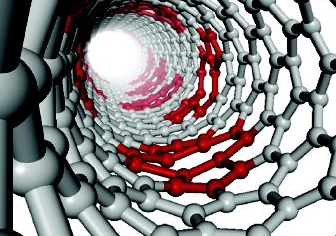Outstanding thermal transport properties of carbon nanotubes (CNTs) qualify them as possible candidates to be used as thermal management units in electronic devices. However, significant variations in the thermal conductivity (Κ) measurements of individual CNTs restrict their utilizations for this purpose. In order to address the possible sources of this large deviation and to propose a route to solve this discrepancy, we systematically investigate the effects of varying concentrations of randomly distributed multiple defects (single and double vacancies, Stone-Wales defects) on the phonon transport properties of armchair and zigzag CNTs with lengths ranging between a few hundred nanometers to several micrometers, using both nonequilibrium molecular dynamics and atomistic Green's function methods. Our results show that, for both armchair and zigzag CNTs, Κ converges nearly to the same values with different types of defects, at all lengths considered in this study. On the basis of the detailed mean free path analysis, this behavior is explained with the fact that intermediate and high frequency phonons are filtered out by defect scattering, while low frequency phonons are transmitted quasi-ballistically even for several micrometer long CNTs. Furthermore, an analysis of variances in Κ for different defect concentrations indicates that defect scattering at low defect concentrations could be the source of large experimental variances, and by taking advantage of the possibility to create a controlled concentration of defects by electron or ion irradiation, it is possible to standardize Κ with minimizing the variance. Our results imply the possibility of phonon engineering in nanostructured graphene based materials by controlling the defect concentration.

Outstanding thermal transport properties of carbon nanotubes (CNTs) qualify them as possible candidates to be used as thermal management units in electronic devices. However, significant variations in the thermal conductivity (Κ) measurements of individual CNTs restrict their utilizations for this purpose. In order to address the possible sources of this large deviation and to propose a route to solve this discrepancy, we systematically investigate the effects of varying concentrations of randomly distributed multiple defects (single and double vacancies, Stone-Wales defects) on the phonon transport properties of armchair and zigzag CNTs with lengths ranging between a few hundred nanometers to several micrometers, using both nonequilibrium molecular dynamics and atomistic Green's function methods. Our results show that, for both armchair and zigzag CNTs, Κ converges nearly to the same values with different types of defects, at all lengths considered in this study. On the basis of the detailed mean free path analysis, this behavior is explained with the fact that intermediate and high frequency phonons are filtered out by defect scattering, while low frequency phonons are transmitted quasi-ballistically even for several micrometer long CNTs. Furthermore, an analysis of variances in Κ for different defect concentrations indicates that defect scattering at low defect concentrations could be the source of large experimental variances, and by taking advantage of the possibility to create a controlled concentration of defects by electron or ion irradiation, it is possible to standardize Κ with minimizing the variance. Our results imply the possibility of phonon engineering in nanostructured graphene based materials by controlling the defect concentration.
